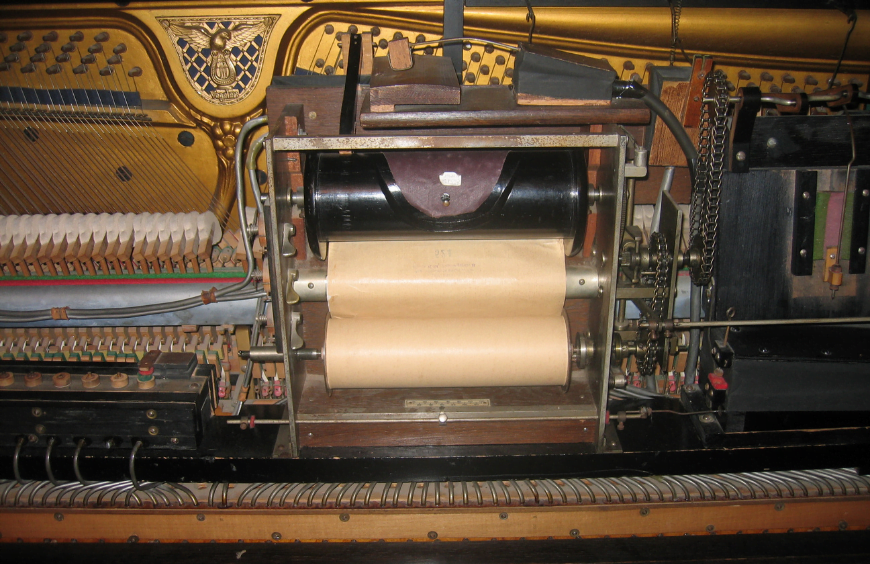No products in the cart.

A player piano, also known as a pianola, is a unique type of piano that can play music automatically without the need for a human pianist. It contains a mechanical or electro-mechanical mechanism that operates the piano action based on a programmed music recording.
Player pianos were popular during the late 19th and early 20th centuries. The music for the player piano is typically recorded on perforated paper rolls or, in some cases, metallic rolls. The rolls have holes punched into them to represent the notes and the timing of the music. When the roll is placed on the piano, it activates the pneumatic or electro-mechanical system, which in turn triggers the corresponding keys and pedals to produce the desired music.
In more modern imple mentations, player pianos can also use MIDI (Musical Instrument Digital Interface) technology. Instead of physical rolls, the music is stored in a digital format and can be played back using MIDI commands. This allows for greater flexibility and versatility in programming and playing music on a player piano.
mentations, player pianos can also use MIDI (Musical Instrument Digital Interface) technology. Instead of physical rolls, the music is stored in a digital format and can be played back using MIDI commands. This allows for greater flexibility and versatility in programming and playing music on a player piano.
Player pianos are fascinating instruments that provide a unique way to enjoy music. They have historical significance and continue to be appreciated by enthusiasts and collectors today.
The idea of automatic musical devices can be traced back many centuries, and the use of pinned barrels to operate percussion mechanisms (such as striking bells in a clock) was perfected long before the invention of the piano. These devices were later extended to operate musical boxes, which contain a set of tuned metal teeth plucked by the player mechanism.
From the early days, manufacturers sought to create mechanisms which would pick out the melody of a musical composition over the background of the rest of the music in the same manner as a live pianist.
The player piano would provide aspiring pianists and music lovers with the technical dexterity they lacked while permitting them to control the musical performance interactively as if they were an accomplished pianist.
Today, as an example, Steinway Spirio, the world’s finest player piano system, available exclusively on select Steinway grand pianos. Yamaha Disklavier is a real acoustic piano outfitted with electronic sensors for recording and electromechanical solenoids for player piano-style playback. KAWAI IQ… and few others..

PianoDisc is the world’s most advanced high-resolution computerized piano player system that can be fitted to almost any acoustic piano that plays live piano.
QRS, The Next Generation Of Player Piano Technology.
The piano player system does not alter the touch, the tone or the performance level of the piano of the piano it is installed in… The acoustic system, that plays on the piano acoustically, and background music that can include vocals, instrumentals, and more through a speaker system.
Is it costly?
The cost of a player piano can vary depending on several factors, including the brand, condition, age, and the specific features and mechanisms it possesses. Vintage player pianos from the late 19th and early 20th centuries can be found in a wide range of prices, depending on their rarity and condition. Restored or well-preserved antique player pianos can command higher prices.
In terms of more modern implementations, player pianos that utilize MIDI technology tend to be more expensive due to the additional electronic components and capabilities they offer. These types of player pianos often come with built-in speakers, digital interfaces, and advanced programming features, which contribute to their higher cost.
Additionally, the cost of maintenance and repairs should also be considered when owning a player piano, especially when dealing with older or antique instruments. It’s essential to factor in the potential expenses of restoring and maintaining the mechanical components, such as the pneumatic system or the electro-mechanical mechanisms.
Overall, player pianos can range from a few thousand dollars for a basic used instrument to tens of thousands of dollars for high-quality, fully restored vintage models or modern player pianos with advanced features. It’s advisable to research and consult with experts or piano dealers to get a better idea of the specific costs associated with the type of player piano you are interested in.
Are player pianos system worth it?
The worth of a player piano depends on personal preferences, such as musical enjoyment, historical value, aesthetic appeal, interactive and educational value. Player pianos are not an investment..unlike a fine piano, yes, it is a super cool feature.. but why anyone would own a piano if they didn’t play it themselves….

